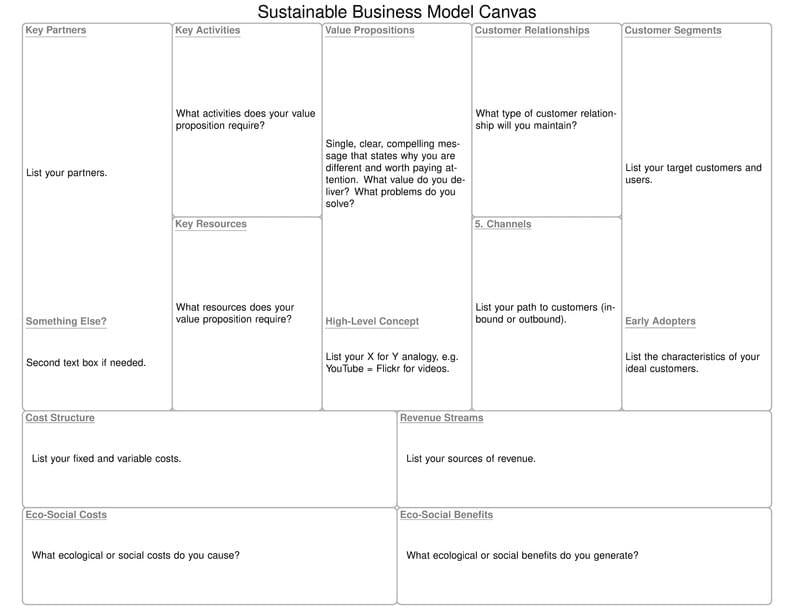
Sustainable Business Model Canvas Template

\documentclass{article}
% Made by Christopher Kaba
% Adapted from Florian Minges' adaptation of Alejandro Ochoa's Grant Model Canvas:
% https://github.com/OchoaLab/grantModelCanvas
% His notes regarding inspiration for the code:
% adapted "business" version from latex code:
% https://rememberthecmd.blogspot.com/2015/02/draw-business-model-generation-canvas.html
% and the "grant" version (not latex):
% https://gregglab.neuro.utah.edu/2018/10/30/the-grant-model-canvas-for-developing-great-grants/
%%%%%%%%%%%%%%%%%%%%%%%%
%%%% DOCUMENT START %%%%
%%%%%%%%%%%%%%%%%%%%%%%%
\usepackage[landscape,margin=0in]{geometry}
%\usepackage[english]{babel}
\usepackage[utf8]{inputenc}
\pagenumbering{gobble} % supress page numbers
\usepackage{hyperref}
% Sans-serif fonts
\renewcommand{\rmdefault}{phv}
\renewcommand{\sfdefault}{phv}
\usepackage{tikz}
\title{\vspace{-2em}Sustainable Business Model Canvas}
\date{}
\author{}
\begin{document}
\maketitle
\vspace{-5em}
\centering
\def\layersep{9.7em}
\def\layerwidth{75em}
\makebox[\textwidth][c]{
\begin{tikzpicture}[
% Define block parameters (mostly shape)
bloc/.style={
rectangle, rounded corners,
draw=black!30, very thick, inner sep=0,
},
invisible/.style={
rectangle, draw=none,
inner sep=0,
},
bloc1/.style={
bloc,
text width = \layerwidth/5*0.95,
minimum width = \layerwidth/5,
minimum height= 4*\layersep
},
bloc2/.style={
bloc,
text width = \layerwidth/5*0.95,
minimum width=\layerwidth/5,
minimum height=2*\layersep
},
bloc3/.style={
bloc,
text width=\layerwidth/2*0.95,
minimum width=\layerwidth/2,
minimum height=\layersep
},
invisible_bloc1/.style={
invisible,
text width=\layerwidth/5*0.95,
minimum width=\layerwidth/5,
minimum height=\layersep
},
invisible_bloc2/.style={
invisible,
text width=\layerwidth/5*0.95,
minimum width=\layerwidth/5,
minimum height=3*\layersep
},
title/.style={
anchor=north west,
color=black!50,
font=\bfseries
},
subtitle/.style={
anchor=north west,
color=black!50,
font=\bfseries
},
]
%%%%%%%%%%%%%%%%%%%%%%%%%
%%%% DRAW THE CANVAS %%%%
%%%%%%%%%%%%%%%%%%%%%%%%%
% first the block, then the title
% 1. KEY PARTNERS
\node[bloc1] (b1) at (0*\layerwidth/10,4*\layersep) {};
\node[title] at (b1.north west) {\underline{Key Partners}};
\node[invisible_bloc2] (b11) at (0*\layerwidth/10,4.45*\layersep) {
List your partners.
};
\node[invisible_bloc1] (b12) at (0*\layerwidth/10,2.5*\layersep) {
Second text box if needed.
};
\node[title] at (b12.north west) {\underline{Something Else?}};
% 4. KEY ACTIVITIES
\node[bloc2] (b2) at (2*\layerwidth/10,5*\layersep) {
What activities does your value proposition require?
};
\node[title] at (b2.north west) {\underline{Key Activities}};
% 8. KEY RESOURCES
\node[bloc2] (b3) at (2*\layerwidth/10,3*\layersep) {
What resources does your value proposition require?
};
\node[title] at (b3.north west) {\underline{Key Resources}};
% 7. COST STRUCTURE
\node[bloc3] (b4) at (1.5*\layerwidth/10,1.5*\layersep) {
List your fixed and variable costs.
};
\node[title] at (b4.north west) {\underline{Cost Structure}};
% 6. REVENUE STREAMS
\node[bloc3] (b5) at (6.5*\layerwidth/10,1.5*\layersep) {
List your sources of revenue.
};
\node[title] at (b5.north west) {\underline{Revenue Streams}};
% 7. ECO-SOCIAL COSTS
\node[bloc3] (b6) at (1.5*\layerwidth/10,0.5*\layersep) {
What ecological or social costs do you cause?
};
\node[title] at (b6.north west) {\underline{Eco-Social Costs}};
% 6. ECO-SOCIAL BENEFITS
\node[bloc3] (b7) at (6.5*\layerwidth/10,0.5*\layersep) {
What ecological or social benefits do you generate?
};
\node[title] at (b7.north west) {\underline{Eco-Social Benefits}};
% 3. VALUE PROPOSITIONS
\node[bloc1] (b8) at (4*\layerwidth/10,4*\layersep) {};
\node[title] at (b8.north west) {\underline{Value Propositions}};
\node[invisible_bloc2] (b81) at (4*\layerwidth/10,4.45*\layersep) {
Single, clear, compelling message that states why you are different and worth paying attention.
What value do you deliver?
What problems do you solve?
};
\node[invisible_bloc1] (b82) at (4*\layerwidth/10,2.5*\layersep) {
List your X for Y analogy, e.g. YouTube = Flickr for videos.
};
\node[title] at (b82.north west) {\underline{High-Level Concept}};
% 9. CUSTOMER RELATIONSHIP
\node[bloc2] (b9) at (6*\layerwidth/10,5*\layersep) {
What type of customer relationship will you maintain?
};
\node[title] at (b9.north west) {\underline{Customer Relationships}};
% 5. CHANNELS
\node[bloc2] (b10) at (6*\layerwidth/10,3*\layersep) {
List your path to customers (inbound or outbound).
};
\node[title] at (b10.north west) {\underline{5. Channels}};
% 2. CUSTOMER SEGMENTS
\node[bloc1] (b11) at (8*\layerwidth/10,4*\layersep) {};
\node[title] at (b11.north west) {\underline{Customer Segments}};
\node[invisible_bloc2] (b111) at (8*\layerwidth/10,4.45*\layersep) {
List your target customers and users.
};
\node[invisible_bloc1] (b112) at (8*\layerwidth/10,2.5*\layersep) {
List the characteristics of your ideal customers.
};
\node[title] at (b112.north west) {\underline{Early Adopters}};
\end{tikzpicture}
}
\end{document}